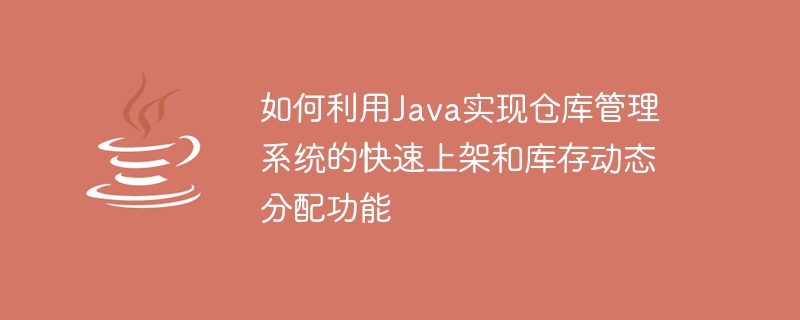

How to use Java to realize the rapid shelving and dynamic inventory allocation functions of the warehouse management system
Introduction:
The rapid shelving and dynamic inventory allocation of the warehouse management system are modern An important link in supply chain management. By utilizing the Java programming language, we can implement these functions very well. This article will introduce in detail how to use Java to implement the rapid shelving and dynamic inventory allocation functions of the warehouse management system, and provide specific code examples.
1. Implementation of the quick shelving function
Quick shelving refers to quickly putting newly arrived goods on the shelves in the warehouse for subsequent shipment and inventory management. In Java, we can use object-oriented ideas to create two classes, cargo and warehouse, and implement quick shelving functions through the attributes and methods of the classes.
Create goods class (Goods)
public class Goods {
private String id; // 货物ID
private String name; // 货物名称
private int quantity; // 货物数量
public Goods(String id, String name, int quantity) {
this.id = id;
this.name = name;
this.quantity = quantity;
}
// Getter和Setter方法省略
// 上架货物的方法
public void shelfGoods(int quantity) {
this.quantity += quantity;
System.out.println("货物上架成功!");
}
}Create warehouse class (Warehouse)
public class Warehouse {
private List<Goods> goodsList; // 仓库中的货物列表
public Warehouse() {
goodsList = new ArrayList<>();
}
// Getter和Setter方法省略
// 将货物上架到仓库的方法
public void addGoods(Goods goods) {
goodsList.add(goods);
System.out.println("货物上架成功!");
}
}Usage example
public class Main {
public static void main(String[] args) {
Goods goods = new Goods("001", "电视机", 10);
Warehouse warehouse = new Warehouse();
warehouse.addGoods(goods);
}
}2. Implementation of dynamic inventory allocation function
Dynamic inventory allocation refers to dynamically allocating goods in the warehouse according to order requirements to ensure that customer needs are met in a timely manner. In Java, we can use syntax such as collections and conditional judgments to implement dynamic inventory allocation functions.
Modify the goods category (Goods)
public class Goods {
private String id; // 货物ID
private String name; // 货物名称
private int quantity; // 货物数量
public Goods(String id, String name, int quantity) {
this.id = id;
this.name = name;
this.quantity = quantity;
}
// Getter和Setter方法省略
// 扣除货物数量的方法
public boolean deductQuantity(int quantity) {
if (this.quantity >= quantity) {
this.quantity -= quantity;
System.out.println("库存扣除成功!");
return true;
} else {
System.out.println("库存不足,无法完成扣除!");
return false;
}
}
}Modify the warehouse category (Warehouse)
public class Warehouse {
private List<Goods> goodsList; // 仓库中的货物列表
public Warehouse() {
goodsList = new ArrayList<>();
}
// Getter和Setter方法省略
// 根据订单需求从仓库中分配货物的方法
public boolean allocateGoods(String goodsId, int quantity) {
for (Goods goods : goodsList) {
if (goods.getId().equals(goodsId)) {
return goods.deductQuantity(quantity);
}
}
System.out.println("找不到对应的货物!");
return false;
}
}Usage examples
public class Main {
public static void main(String[] args) {
Goods goods = new Goods("001", "电视机", 10);
Warehouse warehouse = new Warehouse();
warehouse.addGoods(goods);
// 模拟订单需求
String goodsId = "001";
int demandQuantity = 5;
warehouse.allocateGoods(goodsId, demandQuantity);
}
}Conclusion:
Through the above examples, we can see that the Java programming language can be used to easily implement the rapid shelving and dynamic inventory allocation functions of the warehouse management system. Through object-oriented thinking, combined with syntax such as sets and conditional judgments, the system can be made more flexible and practical. I hope this article can help readers understand and apply the Java programming language to implement related functions of the warehouse management system.
The above is the detailed content of How to use Java to implement the rapid shelving and dynamic inventory allocation functions of the warehouse management system. For more information, please follow other related articles on the PHP Chinese website!




